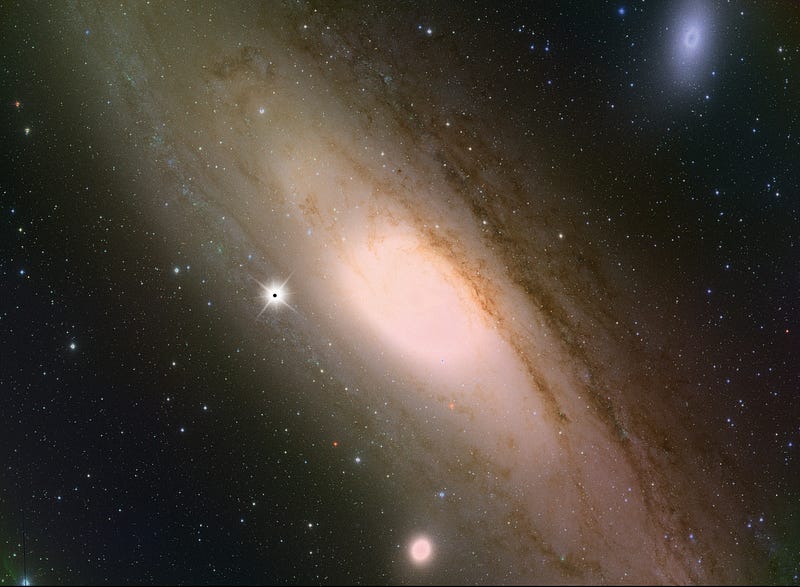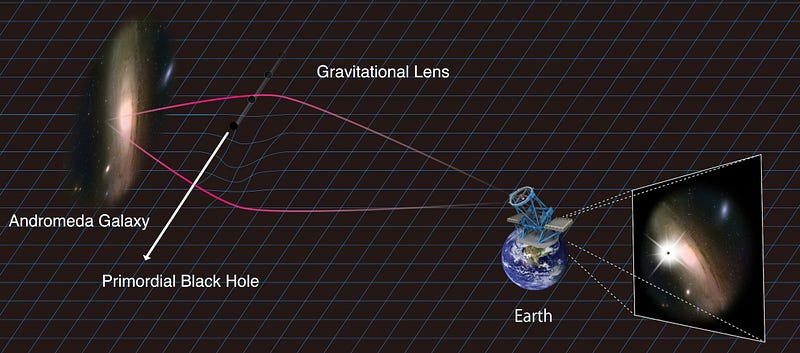Unraveling the Mystery of Dark Matter: A New Perspective
Written on
Chapter 1: Hawking's Prediction and Its Challenges
In 1974, the renowned physicist Stephen Hawking proposed that dark matter, which constitutes 85% of the universe, could be tiny black holes formed in the universe's infancy. However, a new investigation by astronomers using the Subaru telescope in Hawaii has revealed that this hypothesis may not hold true.
Hawking theorized that black holes smaller than a millimeter (about 1/25th of an inch) would generate the gravitational forces necessary to maintain the structure of galaxies and influence their rotation, including that of our own Milky Way.

The Andromeda Galaxy, like our own Milky Way, contains dark matter — its nature remains elusive, but we are beginning to discard certain theories.
Section 1.1: Dark Matter's Elusive Nature
Dark matter refers to a mysterious substance that cannot be observed directly and emits no radiation, yet exerts enough gravitational force to bind galaxies together and influence the motion of objects at their peripheries. The initial evidence for dark matter was presented by astronomer Fritz Zwicky in 1933, with further confirmation by Vera Rubin in the 1970s. Since then, scientists have been grappling with the essence of dark matter, knowing more about what it isn’t than what it is.
Subsection 1.1.1: Possible Candidates for Dark Matter
NASA suggests that dark matter might consist of brown dwarfs—failed stars that never ignited due to insufficient mass—or white dwarfs, which are the remnants of small to medium-sized stars. It could also be neutron stars or black holes, remnants of larger stars after their supernova explosions.

Nevertheless, each of these possibilities faces significant hurdles. For instance, the quantity of white or brown dwarfs is likely insufficient to explain the immense gravitational influence attributed to dark matter. Neutron stars and black holes are also exceedingly rare. While exotic subatomic particles might be a candidate for dark matter, experimental efforts to detect them have yet to yield results. The Fermi Space Telescope, designed to observe gamma-ray emissions from collisions of exotic dark matter particles, has similarly reported no findings.
Section 1.2: The Search for Primordial Black Holes
If these miniature black holes do exist, they would theoretically warp the surrounding space, causing light from distant stars to bend and brighten, akin to a lens focusing sunlight on a sidewalk. As the black hole moves, the star would appear to dim. Researchers employed the Subaru Telescope to monitor light from stars in the Andromeda Galaxy, hoping to observe the expected fluctuations, but found no evidence supporting Hawking's predictions.
Chapter 2: The Experiment's Findings
The first video titled "Stephen Hawking Proven Wrong - Black Holes Are Not Dark Matter" delves into the implications of this new research, exploring how it challenges Hawking's long-standing theories about dark matter.
To successfully observe a gravitational lensing event, a precise alignment between a star and a primordial black hole is essential, a scenario that is rare and expected to last only a few minutes to hours. The Hyper Suprime-Cam attached to the Subaru Telescope was utilized to maximize the likelihood of capturing these fleeting moments.

The Experiment
“From 190 consecutive images of the Andromeda Galaxy taken over seven hours in clear conditions, our team diligently searched for potential gravitational lensing events. If dark matter were indeed composed of primordial black holes of a certain mass—specifically, those lighter than the moon—we would expect to identify around 1000 such events. However, after thorough analysis, we could only find one instance,” the researchers stated in a press release from the Subaru Telescope.
These findings imply that primordial black holes could constitute merely 0.1 percent of all dark matter, indicating that miniature black holes are unlikely to be the solution to this profound cosmic puzzle.
The second video titled "What If (Tiny) Black Holes Are Everywhere?" further examines the implications of these findings, questioning the very nature of dark matter and what lies beyond our current understanding of the universe.